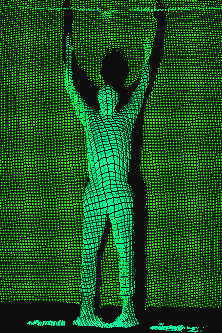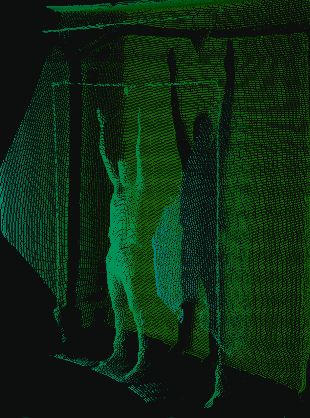
The Importance of the Overhead Squat Screen
and How New Technology is Changing the Game
By Jonathan Gagnon, M.Ed, CSCS
Owner, Hybrid Health and Performance
Adjunct Professor of Kinesiology, University of Maine & Kinotek Advisor
Most professional trainers, physical therapists, chiropractors, or coaches, would agree with the following statement:
“In order to mitigate injury risk and improve performance, professionals should strongly consider first completing a baseline movement screening before creating a client exercise program.”
What’s a good way to start screening your clients? A good place to start can be the overhead squat, or many of its modifications. This “go to” movement is used in both fitness and rehabilitation to understand client movement strategies, identify compensations, and help inform the right exercise program.
The overhead squat is not the only screen you should do–and that’s a subject for a later post. So, given the importance of this core movement, in this post I’d like to share:
Why the overhead squat is so useful
How to analyze the overhead squat
Typical client movement patterns and potential causes
New technologies to make the overhead squat assessment faster and easier
Why the Overhead Squat is So Useful
While some consider the overhead squat overrated, it offers many useful insights. Here are three important ones:
You get a full-body movement overview. In less than five seconds, you can get a complete view of general mobility, core strength, and balance.
You see left/right asymmetries. Imbalances reveal themselves pretty quickly.
You see the whole kinetic chain. You may find that the root of your client’s knee pain starts in the ankles or hips.
How to Analyze the Overhead Squat: A Manual Approach
Conducting an overhead squat screen is traditionally a manual process relying on visual observation. Various accredited programs, such as FMS™ and NASM, provide comprehensive training and practical methods for scoring these observations. Some systems employ a straightforward three-point scale to evaluate overall movement quality, while others use a checklist to systematically identify specific movement patterns within the squat. Scoring establishes a baseline and is currently the only practical and affordable quantitative way to measure and demonstrate progress. You need to observe, then write down/input your score somewhere (or keep in your head!).
Current practical approaches to conducting an overhead squat screen are manual, relying on visual observation and a simple scoring system
As for documenting the visual, some professionals may record a phone video, while a few may break out a phone app to manually draw angles on a picture. These methods can be cumbersome. For someone new to their profession, it may take a few years to become proficient, consistent, and confident in the observations and scoring.
Typical Client Movement Patterns and Potential Causes
The following chart provides a quick guide for trainers on the overhead squat. Note that this chart is not complete or diagnostic, simply a quick guide to get started:
For a deeper dive into the overhead squat assessment, check out this post by Tyler Read at PTP.
New Technologies Make the Overhead Squat Assessment Faster & Easier
Wouldn't it be amazing if technology could perform this screen to support you? Good news: advances in sensor free motion-capture cameras and computer vision technology have made this a reality. What is computer vision? Google’s Gemini AI offers this:
Computer vision (CV) is a field of artificial intelligence (AI) that uses machine learning and neural networks to teach computers to understand and interpret visual data. The goal of CV is to enable computers to analyze and understand visual data in a similar way to human brains and eyes, and to use that understanding to make decisions.
Kinotek has brought together all of this technology–the sensor-free device, and an AI-trained proprietary neural network model – to enable any professional to do a scored overhead squat screen in seconds. The analysis is complete with metrics, a score, 3D visuals, and client-friendly reports.
Kinotek’s LiDAR camera captures the visuals, and its proprietary neural network translates this input into client-friendly reports and 3D visuals—in seconds—to support professionals. The company’s latest innovation: a “Movement Quality Report” for the overhead squat (more to come!).
As an advisor to Kinotek, I’ve had the pleasure of helping design, develop and validate the company’s product, including its newest Movement Quality Report (MQR) that enables the squat analysis shown in the above chart. The platform currently offers 65 movements for mobility analysis, and is actively building its portfolio of complementary “quality” reports for key movements.
Kinotek’s new Movement Quality Report displays the mobility score side-by-side with the new quality score for the overhead squat: how was the depth? did the arms fall forward? was there a hip shift?
There are several benefits of using technology like Kinotek to complete an overhead squat screen:
Objective data, with metrics for mobility, asymmetries, compensations and quality
Built-in consistency for yourself and across all professionals on a team
Automatic documentation, including the data and visuals
Ability to share with clients–there’s a “wow” factor when clients see themselves in 3D!
Ability to measure and tangibly show progress
Conclusion
In the end, any wellness or medical professional wants to help their clients achieve their goals while mitigating injury. Programming the right exercises, based on their current body mechanics, is critical. With all the advances in technology, it makes sense that someone would finally create an app to quickly, efficiently, and objectively screen the overhead squat to support professionals. Perhaps my opening sentence can be modified:
In order to mitigate injury risk and improve performance, professionals should strongly consider first completing a baseline movement screening before creating an exercise program…using the latest technology.
Jon Gagnon earned his Master's Degree in Kinesiology through the University of Maine where he now teaches Kinesiology in the undergraduate program. As the owner of Hybrid Health & Performance, he works with a diverse group of athletes, as well as fitness enthusiasts of all ages and ability levels, looking to improve the way they move and feel.
What can you achieve with Kinotek?
Kinotek’s advanced technology objectively measures dynamic movement health in seconds. Our visual scored report inspires and motivates clients to join your club and sign up for personal training services. Measuring movement health can help you attract new members and new clients to your personal training services. See for yourself today.







